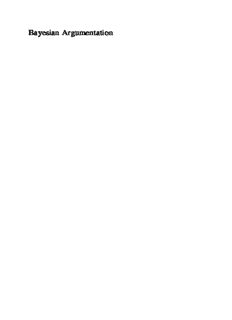
Bayesian Argumentation: The Practical Side of Probability PDF
Preview Bayesian Argumentation: The Practical Side of Probability
Bayesian Argumentation SYNTHESE LIBRARY STUDIES IN EPISTEMOLOGY, LOGIC, METHODOLOGY, AND PHILOSOPHY OF SCIENCE Editors-in-Chief: VINCENT F. HENDRICKS, University of Copenhagen JOHN SYMONS, University of Texas at El Paso, U.S.A. Honorary Editor: JAAKKO HINTIKKA, Boston University, U.S.A. Editors: DIRK VAN DALEN, University of Utrecht, The Netherlands THEO A.F. KUIPERS, University of Groningen, The Netherlands TEDDY SEIDENFELD, Carnegie Mellon University, U.S.A. PATRICK SUPPES, Stanford University, California, U.S.A. JAN WOLEN´SKI, Jagiellonian University, Krako´w, Poland VOLUME 362 For furthervolumes: http://www.springer.com/series/6607 Frank Zenker Editor Bayesian Argumentation The practical side of probability Editor FrankZenker Philosophy LundUniversity Lund,Sweden ISBN978-94-007-5356-3 ISBN978-94-007-5357-0(eBook) DOI10.1007/978-94-007-5357-0 SpringerDordrechtHeidelbergNewYorkLondon LibraryofCongressControlNumber:2012953573 #SpringerScience+BusinessMediaDordrecht2013 Thisworkissubjecttocopyright.AllrightsarereservedbythePublisher,whetherthewholeorpart of the material is concerned, specifically the rights of translation, reprinting, reuse of illustrations, recitation,broadcasting,reproductiononmicrofilmsorinanyotherphysicalway,andtransmissionor informationstorageandretrieval,electronicadaptation,computersoftware,orbysimilarordissimilar methodologynowknownorhereafterdeveloped.Exemptedfromthislegalreservationarebriefexcerpts inconnectionwithreviewsorscholarlyanalysisormaterialsuppliedspecificallyforthepurposeofbeing enteredandexecutedonacomputersystem,forexclusiveusebythepurchaserofthework.Duplication ofthispublicationorpartsthereofispermittedonlyundertheprovisionsoftheCopyrightLawofthe Publisher’s location, in its current version, and permission for use must always be obtained from Springer.PermissionsforusemaybeobtainedthroughRightsLinkattheCopyrightClearanceCenter. ViolationsareliabletoprosecutionundertherespectiveCopyrightLaw. The use of general descriptive names, registered names, trademarks, service marks, etc. in this publicationdoesnotimply,evenintheabsenceofaspecificstatement,thatsuchnamesareexempt fromtherelevantprotectivelawsandregulationsandthereforefreeforgeneraluse. While the advice and information in this book are believed to be true and accurate at the date of publication,neithertheauthorsnortheeditorsnorthepublishercanacceptanylegalresponsibilityfor anyerrorsoromissionsthatmaybemade.Thepublishermakesnowarranty,expressorimplied,with respecttothematerialcontainedherein. Printedonacid-freepaper SpringerispartofSpringerScience+BusinessMedia(www.springer.com) Foreword This volume collects contributions to the international workshop on Bayesian Argumentation held on 22–23 October 2010 at the Philosophy Department of LundUniversity,Sweden. IwouldliketoexpressmygratitudetotheSwedishResearchCouncil(VR)and theWenner-GrenFoundationsfortheirgenerousfinancialsupportofthisevent,and toallspeakersandparticipantsforfruitfuldiscussions. ThanksareduetoStefanSchubertforusefulcommentsontheintroduction,toan anonymousreviewerand,lastbutnotleast,toTiesNijssen,IngridvanLaarhoven, andChristiLueatSpringer’sDordrechtoffice. Lund,June2012 FrankZenker v Contents BayesianArgumentation:ThePracticalSideofProbability. . . . . . . . . 1 FrankZenker PartI TheBayesianApproachtoArgumentation TestimonyandArgument:ABayesianPerspective. . . . . . . . . . . . . . . . 15 UlrikeHahn,MikeOaksford,andAdamJ.L.Harris WhyAreWeConvincedbytheAdHominemArgument?:Bayesian SourceReliabilityandPragma-DialecticalDiscussionRules. . . . . . . . . 39 MikeOaksfordandUlrikeHahn PartII TheLegalDomain ASurveyofUncertaintiesandTheirConsequencesinProbabilistic LegalArgumentation. . . . . . . . . . . . . . . . . . . . . . . . . . . . . . . . . . . . . . . 61 MatthiasGrabmairandKevinD.Ashley WasItWrongtoUseStatisticsinRvClark?ACaseStudy oftheUseofStatisticalEvidenceinCriminalCourts. . . . . . . . . . . . . . . 87 AmitPundik PartIII ModelingRationalAgents ABayesianSimulationModelofGroupDeliberation andPolarization. . . . . . . . . . . . . . . . . . . . . . . . . . . . . . . . . . . . . . . . . . . 113 ErikJ.Olsson DegreesofJustification,Bayes’Rule,andRationality. . . . . . . . . . . . . . 135 GregorBetz Argumentationwith(Bounded)RationalAgents. . . . . . . . . . . . . . . . . . 147 RobertvanRooijandKrisdeJaegher vii viii Contents PartIV TheoreticalIssues Reductio,Coherence,andtheMythofEpistemicCircularity. . . . . . . . 165 TomojiShogenji OnArgumentStrength. . .. . . . .. . . .. . . .. . . .. . . .. . . .. . . . .. . . .. 185 NikiPfeifer UppingtheStakesandthePrefaceParadox. . . . . . . . . . . . . . . . . . . . . . 195 JonnyBlamey Index. . . . . . . . . . . . . . . . . . . . . . . . . . . . . . . . . . . . . . . . . . . . . . . . . . . 211 Bayesian Argumentation: The Practical Side of Probability FrankZenker Abstract We give a brief introduction to the Bayesian approach to natural lan- guageargumentation,mainlyorientedtoreadersmorefamiliarwithclassicallogic. Subsequently, we summarize the gist of each of the chapters so as to provide readerswithanoverviewofthebook’scontent. 1 Introduction It is often found not too difficult to compare arguments with respect to their comparative strength or their rational persuasiveness. For present purposes, this may be understood as the capacity of reasons to reduce, sustain, or enhance the extenttowhicharationalagentendorsesaconclusion.Perhaps,theeasiestwayof assessingargumentstrengthconsistsinaskinglistenersforanopinion.But,clearly, whatdoespersuadeneednotbecoextensivewithwhatshouldpersuade. Alesssimplewayconsistsindeployinganormativestandard—herethetheory ofprobability,particularlyitsnotionofevidentialsupport—inordertoanswertwo questions:First,whatpartofprobabilitytheorymightbeusedtowardarrivingata normativeaccountthatyieldsamotivatedseparationofnaturallanguagearguments intogoodandlessgoodones?Secondly,aretheassessmentsofargumentstrength performedinlaymenorinstitutionalcontexts(suchasacourtroom)tosomeextent consistentwiththattheory? Contributions to this volume converge upon the use of Bayes’ theorem (which isintroducedfurtherbelow)asthenorminthelightofwhichevidence—“arriving” in various forms, for example, as a third party report, a test result, or a direct observation—affects the endorsement of some hypothesis. A subset of these contributionsalsoreportdata,someofwhichhasbeenmethodologicallyhardened F.Zenker(*) DepartmentofPhilosophy&CognitiveScience,LundUniversity, Kungshuset,Lundaga˚rd,22222Lund,Sweden e-mail:frank.zenker@fil.lu.se F.Zenker(ed.),BayesianArgumentation:Thepracticalsideofprobability, 1 SyntheseLibrary362,DOI10.1007/978-94-007-5357-0_1, #SpringerScience+BusinessMediaDordrecht2013 2 F.Zenker incontrolledexperimentalsettings,ontheextenttowhicharguerscomplywiththis normornot.Furthercontributionsaddresschallengesarisingin(computationally) modeling rational agents and their argumentative interactions, while yet others offernovelsolutionstolong-standing“anomalies.” Below follows a brief introduction to the formal apparatus, particularly as it appliestothestudyofnaturallanguageargumentation,meantto“pavetheway”for thenovicereader.Anoverviewofthebook’scontentisprovidedinSect.3. 2 The Bayesian Approach to Argumentation Bayes’theorem(BayesandPrice1763)expressestherelationsbetweenahypothe- sis,H,andevidence,E,intermsofprobability,P.Onasubjectivistinterpretation, “probability” denotes degrees of belief. These degrees are mapped onto the unit interval[0,1]suchthatP(H) ¼ 1(cid:2)P(nonH).Therelataarevariouslyreferredtoas: (cid:129) P(H)thepriororunconditionalprobabilityofahypothesis(givennoevidence) (cid:129) P(E)themarginaloraprioriprobabilityoftheevidence (cid:129) P(H|E) the direct or posterior or conditional probability of a hypothesis given theevidence (cid:129) P(E|H)theinverseorconditionalprobabilityoftheevidencegiventhehypothe- sis(aka.thelikelihoodoftheevidence) Toreachtermsstandardlyusedinthestudyofnaturallanguageargumentation(and episodesofreasoningthussuggested),“evidence”willbeinterpretedasreason,ground, orargument,and“hypothesis”asconclusionorproposal.Thoseusedtorepresenting argumentative structures as premise-conclusion complexes of the form P , ..., P ; 1 n ergoCneedtoprojectpremisesintoevidenceandconclusionintohypothesis. Bayes’ theorem may count as noncontroversial and takes the following form,1 whereitisassumed—hereandfurtherbelow—that0 < P(H) < 1and0 < P(E) < 1. 1Toarriveatthetheorem,onemaystartfromabasicaxiomofprobabilitytheorywhichstatesthe probabilityoftheconjunctionofHandE,P(H&E),tobetheprobabilityofEmultipliedbythe probabilityofHgivenE,asexpressedin(1): PðH&EÞ¼PðEÞPðHjEÞ (1) Thesameisstatedin(2): PðH&EÞ¼PðHÞPðEjHÞ: (2) Thisallowsustoequatetherightsidesof(1)and(2)toreach PðEÞPðHjEÞ¼PðHÞPðEjHÞ: (3) Uponwhichdividingbothsidesof(3)byP(E)yields(BT) PðHÞPðEjHÞ ðBTÞ PðHjEÞ¼ PðEÞ
Description: